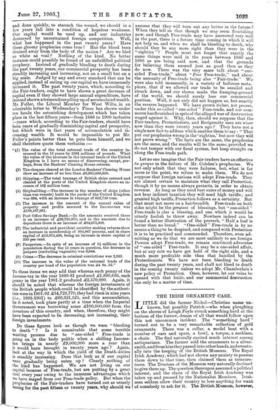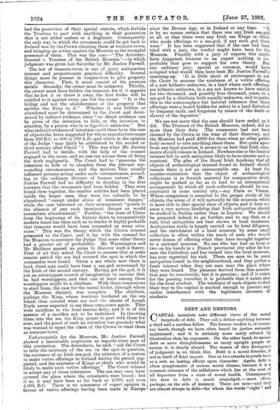THE IRISH ORNAMENT CASE.
-1-4ITTLE did the farmer Nichol—Christian name un- known, but possibly Patrick—who when ploughing on the shores of Lough Foyle struck something hard at the bottom of the furrow, dream of all that would follow upon this not uncommon incident. The " something bard " turned out to be a very remarkable collection of gold ornaments. There was a collar, a model boat with a number of oars and spars, a bowl, a torque, a necklace, a chain. The find naturally excited much interest among antiquarians. The farmer sold the ornaments to a silver- smith, and f rom him they passed into other hands, and eventu- ally into the keeping of the British Museum. The Royal Irish Academy, which had not shown any anxiety to possess them down to that time, then claimed them as treasure- trove. The Trustees of the Museum very naturally declined to give them up. The question thereupon assumed a political interest, and the claim of the Royal Irish Academy was taken up and pressed by the Nationalist Members. Irish- men seldom allow- their country to lose anything for want of somebody to ask for it. The British Museum, however, had the protection of their special statute, which forbids the Trustees to part with anything in their possession that is not either useless or a duplicate. Consequently the only way in which the ornaments could be got back to Ireland. was by the Crown claiming them as treasure-trove, and bringing an action against the Museum as the wrongful possessor of them. This was the case—" The Attorney- General v. Trustees of the British Museum "—in which judgment was given last Saturday by Mr. Justice Farwell.
The law of treasure-trove is one of great antiquarian interest and proportionate practical difficulty. Several things must be present in conjunction to give property this character. First, it must consist of the precious metals. Secondly, the owner must be unknown. Thirdly, the owner must have hidden the treasure, for if it appears that he lost it or threw it away, the first finder will be entitled to it against every one but the owner. " It is the hiding and not the abandonment of the property that entitles the King to it." Whether it was hidden or abandoned must be determined by the Court and deter- mined by indirect evidence, since " no direct evidence can be given of the intention to hide, or the intention to abandon, by a person who is ex hypot/Lesi unknown." But what indirect evidence of intention could there be in the case of objects the dates suggested for whose manufacture range from 300 B.C. to 600 or 700 A.D., and which in the opinion of the Judge " may fairly be attributed to the second or third century after Christ " ? This was what Mr. Justice Farwell had to decide, with the help of the counsel engaged in the cause, and no one can accuse them of doing the work negligently. The Court had to "presume the intention to hide or to abandon from the relevant sur- rounding circumstances, and the motives that usually influence persons acting under such circumstances, accord- ing to the ordinary dictates of human nature." Mr. Justice Farwell had no difficulty in deciding in the first instance that the ornaments had been hidden. They were found close together, the smaller articles had been placed inside the larger ones, they were too valuable to be abandoned " except under stress of imminent danger," while the care bestowed on their arrangement "points to the absence of any such imminent danger as would necessitate abandonment." Further, " the state of 'Ulster from the beginning of its history down to comparatively modern times has been such as to render it highly probable that treasure would have been concealed on many occa- sions." This was the theory which the Crown counsel presented to the Court, and it lay with the counsel for the Museum to convince the Judge that some other theory had a greater air of probability. Mr. Warmington and Mr. Haldane spared no pains to discover such a theory. First of all they asked the Court to assume that at some remote period the sea had covered the spot in which the ornaments were found. Given a sea where now there is land, there may easily have been a sea-god reverenced by the Irish of the second century. Having got the god, it is not an extravagant stretch of imagination to assume that he had worshippers, and that one at least among these worshippers might be a chieftain. With these concessions to start from, the case for the casual finder, through whom the Museum claimed, was complete. The chieftain, perhaps the King, whose territory bordered on the sea which then covered what are now the shores of Lough Foyle never expected to see these ornaments again. They were sacrifices to the local marine deity, and it is of the essence of a sacrifice not to be reclaimed. In throwing them into the sea the King meant to part with them for ever, and the proof of such an intention was precisely what was wanted to upset the claim of the Crown to treat them as treasure-trove.
Unfortunately for the Museum, Mr. Justice Farwell showed a lamentable scepticism as regards every part of this contention. The defendants, he said, " ask the Court to infer the existence of the sea on the spot in question, the existence of an Irish sea-god, the existence of a custom to make votive offerings in Ireland during the period sug- gested, and the existence of Kings or chiefs who would be likely to make such votive offerings." The Court refused to accept any of these inferences. The sea may once have covered the place where the ornaments were found ; but if so, it may have been as far back as 2,000, and even 4,000, B.C. There is no consensus of expert opinion in favour of votive offerings having been made in Europe since the Bronze Age, or in Ireland at any time. " It is by no means certain that there was any Irish sea-god at all, or that there were any Irish sea Kings or chiefs who made offerings to a sea-god, if any such god there were." It has been suggested that if the case had been tried with a jury, the verdict might have been for the Museum. Possibly with a jury of experts this might have happened, because to an expert nothing is im- probable that goes to support his own theory. But any ordinary jury, special or common, would have accepted what would then have been Mr. Justice Farwell's summing-up. It is little short of extravagant to ask the Court to assume the existence of a votive offering of a sort hitherto unknown, in a land where such offerings are hitherto unknown, in a sea not known to have existed for two thousand, and possibly four thousand, years, to a sea-god by a chieftain both equally unknown, and to prefer this to the commonplace but natural inference that these offerings were a hoard hidden for safety in a land disturbed by frequent raids, and forgotten by reason of the death or slavery of the depositor.'
We are not sorry that the case should have ended as it did. The Trustees of the British Museum, indeed, did. no more than their duty. The ornaments had not been claimed by the Crown at the time of their discovery, and the Museum had paid £600 for them when no other public body seemed to care anything about them. But quite apart from any legal question, it seems to us best that Irish orna- ments should remain in Ireland. Nowhere else is the limited interest felt in such antiquities likely to be so sincere and so constant. The plea of the Royal Irish Academy that all objects of archaeological interest found in Ireland should remain there is not an unreasonable one. At least the counter-contention that the object of archaeological collections is to furnish material for comparative study might be pushed so far as to lead to an international arrangement by which all such collections should be con- centrated in some central city,----say Paris or Vienna. Where comparison is essential to the proper study of the objects, the scene of it will naturally be the museum which is most rich in that special class of objects, and it does not seem a very serious hardship that Irish antiquities should be studied in Dublin rather than in London. We should be prepared, indeed, to go further, and to say that, as a rule, local antiquities are best shown in local museums. Antiquarian study is largely carried on by local diligence, and the enrichment of a local museum by some small collection is often within the reach of men who would never dream of offering what they have brought together to a national museum. No one who has had an hour or two on his hands in a French provincial city after he has seen the Cathedral, and has turned into the local museum, has ever regretted his visit. There are sure to be some antiquities found in the neighbourhood, and they gather a fresh interest when they are seen near the place where they were found. The pleasure derived from this associa- tion may be unscientific, but it is genuine ; and if it exists for the passing traveller, it is probable that it exists also for the local student. The tendency of such objects to find their way to the capital is marked enough to prevent any undue interference with the legitimate interests of students.























































 Previous page
Previous page